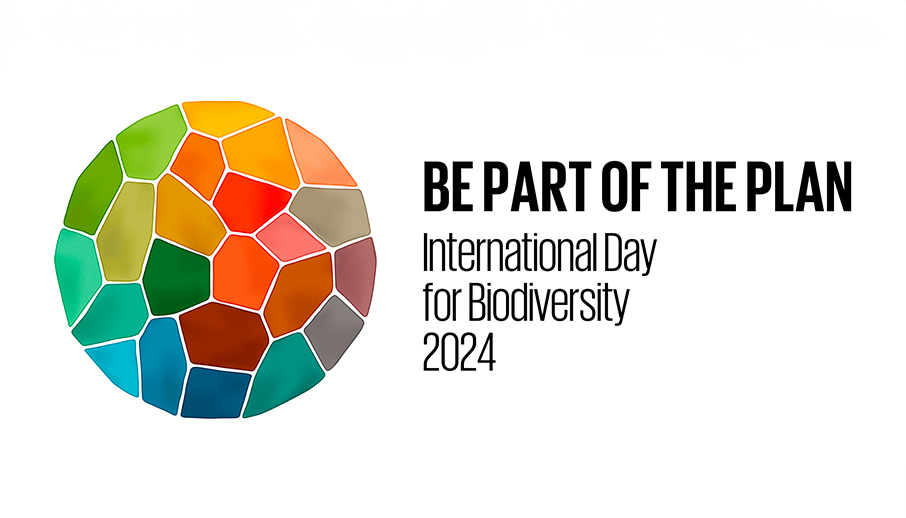International Day for Biological Diversity
Wednesday 22 May 2024
Respecting, protecting, and repairing our natural wealth. Beyond the climate emergency, the world is facing another equally important crisis requiring urgent action: the collapse of biodiversity and nature loss.
Today, we celebrate the International Day for Biological Diversity, entitled ‘Be part of the Plan’.
So, what is biodiversity?
Biodiversity includes all the different kinds of life you can find in one area — the variety of animals, plants, fungi, and even microorganisms like bacteria that make up our natural world. Each of these species and organisms work together in tight ecosystems, like an intricate web, to maintain balance and support life.
Why is it so important?
Despite all our technological advances, we are completely dependent on healthy and vibrant ecosystems for our water, food, medicines, clothes, fuel, shelter, and energy, to name just a few. For this reason, in December 2022, global institutions and organisations met at COP15 and agreed on a common plan to transform our relationship with nature. The adoption by about two hundred institutions of the Kunming-Montreal Global Biodiversity Framework, also known as The Biodiversity Plan, sets goals and concrete measures to stop and reverse the loss of nature by 2050.
Today represents a call to action as protecting biodiversity requires strong collaboration between financial and non-financial institutions to achieve tangible results. Mitigation, adaptation, restoration and climate technology – all require sufficient funds to yield the results our society needs.
So where do we currently stand?
Earlier this month, we published our Statement on Natural Capital and Biodiversity – which can be found here, alongside our other policy frameworks.
We had already addressed several nature-related issues (adopting the Equator Principles, for example, and publishing policies on sensitive sectors alongside commitments on human rights and rainforests), but this represents our first comprehensive Natural Capital framework in which biodiversity and climate issues are interrelated.

Notably, alongside our Net Zero targets and Transition Plan, our Natural Capital Framework also considers the Circular Economy as a key lever for change. We aspire to be at the forefront here by such integrating considerations into our business operations, alongside climate-related initiatives.
At the same time, we are the first Italian bank to have signed up to the Finance for Biodiversity Pledge (FfBP). The FfBP members jointly call for and commit to taking ambitious action on biodiversity to reverse nature loss in this decade. This will be achieved through collaboration, engagement with relevant counterparts and the assessment of our own biodiversity impact.
As signatories of the FfBP we are targeting an initial disclosure of our level of action by 2025.
We also contributed to the first climate and nature nexus paper titled ‘Unlocking the biodiversity-climate nexus’. This paper lays out the key pillars, linking the issues of climate change with those of the impacts on nature.
Moreover, we are a member of the Working Group on Nature within the United Nations Environment Programme Finance Initiative (UNEP FI), related to Principles for Responsible Banking (PRB), for which we are the only Italian bank to have contributed – together with 34 international banks – to the publication of the ‘PRB Nature Target Setting Guidance’. The aim is to help the banking sector align with the Kunming-Montreal Global Biodiversity Framework (GBF) and halt biodiversity loss.
“International Day for Biological Diversity is a moment for us to reflect on the critical importance of our planet’s natural capital. As a pan-European bank, we are working hard to play our part in mitigating climate change and biodiversity loss and, as part of this, we recently published our first Statement on Natural Capital and Biodiversity, which sets out our positioning and principles on the subject. There is plenty of work to be done, but we see this as an exciting challenge to help our clients and our communities take on this sizable – but not insurmountable – task.”
Fiona Melrose, Head of Group Strategy & ESG
Our first steps...
As a preliminary step, we are evaluating sources, methodologies and frameworks to effectively address the key challenges related to biodiversity and nature, in coherence with the Global Biodiversity Framework.
We have also developed a sector-level heatmap of our loan portfolio, aimed at assessing which sectors are most exposed to nature-related risks by gauging their impact on nature.
Finally, we are also working as to actively enhance our understanding of biodiversity and nature. To build institutional awareness around this nascent topic, we are setting up a specific training programme to be made available to all employees by the end of 2024 – do stay tuned for more details.
Our 2023 Integrated Report describes in detail how we intend to create sustainable value over time under a common Purpose of Empowering Communities to Progress, as well as how we monitor the impact the bank’s activities have on Natural Capital.
More details can be found on our dedicated microsite here.
